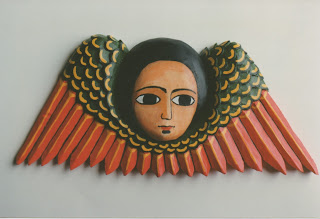This was my first fully in-the-round 3D carving, as opposed to the relief carvings I had done up until this point.
This is Mick Doohan on a '91 Honda NSR500 in classic Rothmans colours which is, in my humble opinion, one of the best paint jobs ever seen on a race bike. Mick had to climb over the front of the bike to get as much weight over the front as possible to help it steer as the Honda at the time was well known for wanting to go in a straight line. The Suzuki 500 and especially the Yamaha 500 were know for their handling but the Honda was the fastest but just didn't want to handle. This shaped the way Mick rode and produced that iconic style of his, having to muscle his bike into doing what he wanted it to do.
This was my first attempt at a realistic figure and didn't work too well. This is where I first came across all the considerations of carving in the round and the pitfalls and complications of juggling all the elements together. It is tough, but it is also so rewarding. As it was carved in pine wood, there isn't a great deal of detail but in my defence I never knew how it was going to end up or how far I could go with it. I was pleased at the time though. The painting of it with acrylic paint hid a lot of the shortcomings of the carving.
Most people who saw it at the time had no idea it was carved in wood or that I had even made it! They thought it was a cast object and that I'd bought it.
You don't have to look too hard to see how rough around the edges it is. After this, I used Lime for the next bikes and it made such a difference. This pictures below are of the next bike carving I did, Eddie Lawson on the Cagiva C591 carved in Lime and you can see how much tidier and crisper the carving is, especially in the out of the way places.
These pictures illustrate the different riding styles of Eddie and Mick.

This was carved in Pine wood, which I think isn't good wood to carve with. It doesn't hold detail very well, it is very hard to get tight straight lines as the different qualities of the dark and light grain of the wood makes it hard to cut accurately.
The darker element of the wood is very hard and the grain can change direction around it so you can be carving a line and all of a sudden, what was going with the grain suddenly changes and becomes against the grain and so the wood tears. You then have to recut the wood to get rid of the tear. This can cause problems especially if you are doing a relief carving as you'll have to go over a lot of the carving again to get an even depth over the surface, and the more you recarve to even off the surface, the more opportunities the wood has to misbehave and change direction on you again.
This may not be too important unless you are doing a piece where accuracy and clean surfaces are important. If you're going to paint it, it may be possible to use filler to hid some of the inconsistencies.
You can see how simple the carving of the Mick Doohan is and how the painting of it hid how simple it is. You can compare it to the Eddie Lawson pictures above and see how much better Lime is for details and crispness. It is also a much nicer looking wood and could be left unpainted and oiled whereas the Pine Mick Doohan carving doesn't really work without the paint. The great Rothmans paint scheme definitely helps raise the finished look of it as well.

























































